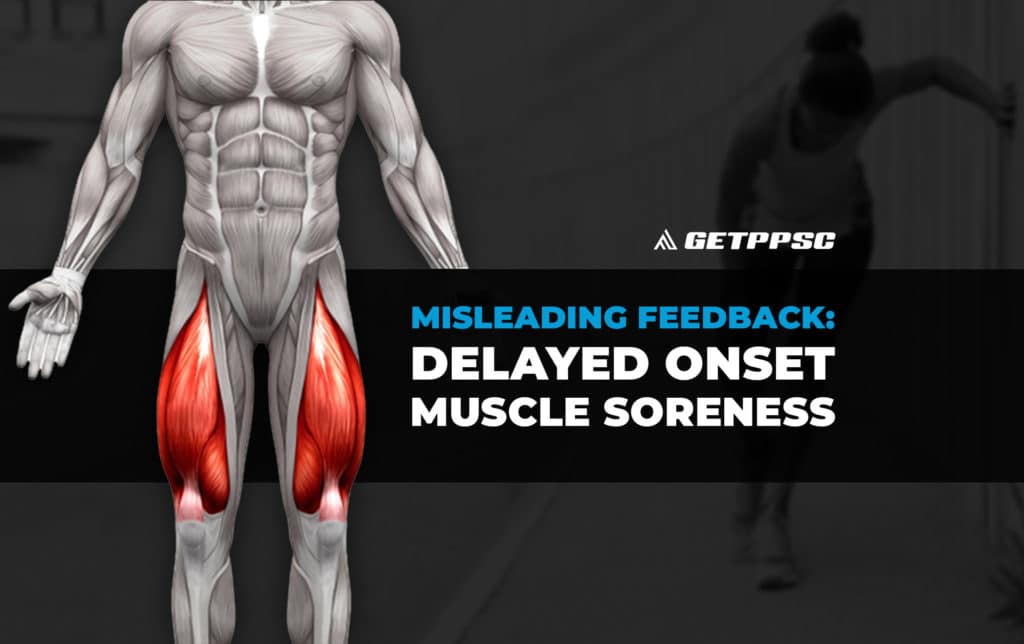Gym Bro – “Dude, I had the most SAVAGE leg day last Wednesday! I still can’t walk straight”
Rational Human – “Uhhh, Tim, it’s Monday. You are seriously still sore”
Gym Bro – “Yeah man! How awesome!”
Actually, that is not awesome. But unfortunately that’s a relatively common conversation we would hear with people who aren’t as well-versed with working out. The fact of the matter is, in the eyes of the amateur fitness enthusiasts, soreness is a highly valued currency.
Where did this fascination with getting sore come from?
I mean, I know for myself soreness sucks! It’s not like it feels awesome – it completely compromises my day and my ability to lift.
Regardless of your feelings on the topic , it’s important to get a more intimate knowledge of what soreness is, where it comes from, and ultimately how we can navigate the conversation with friends and clients in regards to it.
What is Muscle Soreness (DOMS)

If you read up on the topic in journals it’s generally listed as Exercise-Induced Muscle Damage (EIMD) or Delayed Onset Muscle Soreness (DOMS).
The most important distinction between the two are EIMD is the process of what happens when working out to a certain level while DOMS is the potential “feeling”.
Don’t race to your local gym to ask some of the bro’s why you are feeling sore after your workout. Most likely, you will hear the wrong information (we will talk about what it ISN’T later in this article).
DOMS for the sake of this conversation is persistent muscle soreness that lingers around for anywhere between 24-72 hours after repeated bouts of exercise.
This soreness has been well researched and has been linked to eccentric (the stretching contraction of the muscle) as well as unaccustomed exercises.
Feeling the “burn” isn’t going to be the link on why you are getting major soreness over the next week. It may contribute to increased blood concentration and hormone response, but not soreness.
Exercise-Induced Muscle Soreness is going to be a feeling associated with exercise but not an implication of success or how effective the movement was. As previously stated, it’s primarily based on how much eccentric work you do and how many new stimuli you are introducing.
System Implications

What happens in the muscle is really fascinating. Soreness isn’t a great indicator of the workout quality but there are some implications of what DOMS may be caused from:
• Overstretching and Tearing of Tissue
• Small tears leading to release of contractile substances such as Creatine Kinase (CK) and Myoglobin (Mb)
• Altered Calcium Regulation at the Cell
• Inflammation
• Spasms
The most important thing to take away from muscle soreness is understanding its related to muscle trauma. Let’s make a clear distinction, that means trauma – not necessarily adaptation.
Just because there is an act that can damage the muscle does not mean it’s going to translate into upregulated protein synthesis, endocrine secretion, and muscle production.
Let’s get nerdy
From a cellular level, there are two names you want to know:
Myoglobin (Mb) – a protein found in muscle cells which is used as an oxygen storage unit.
Creatine Kinase (CK) – a muscle specific enzyme and both Mb and CK are markers for muscle injury.
The numerous studies completed looking at DOMS have been most tightly related to observing these two serum markers which is why it’s important to know them.
But what happens with the microtears at an even deeper level?

These micro tears we discussed previously in the muscle from training lead to alteration of the Sarcoplasmic Reticulum, the enclosing membrane in the muscle tissue which stores calcium.
Damage to this area through exercise can lead to changes in Ph and temperature within the fiber leading to more free floating calcium.
The implications to alter calcium regulation is a highly important one with regards to the muscle. If you aren’t already aware, calcium is essential for muscle contraction. Without calcium availability at the muscle, contraction would be incapable of happening.
Whether its CK, Mb, or Ca+, the physiological base of soreness is a good one to better understand. What the takeaway should be is we aren’t POSITIVE on why someone feels sore from certain bouts of movement.
All we know is one of these mechanisms caused this pain response.
What Muscle Soreness Isn’t
I am going to make this one short, we know muscle soreness isn’t Lactic Acid buildup in the muscle tissue….
Lactic acid is built up as a byproduct of your short-term energy system when you are running (not necessarily literally running) on low oxygen.
Think about running a 400m dash, biking as fast as you can uphill, or even running in the final 100m of a mile run.
When your body is incapable of oxygenating the muscle tissue there will be increases in blood lactate – before you ultimately hit your blood lactate threshold which would fatigue you out.
The most important part to remember when debunking this long-lived myth is in aerobic scenarios (aerobic metabolism), the removal of lactate matches the production of lactate.
Once you are back into a stable scenario, it shouldn’t be too long after your workout that you clear all the lactic acid within your system. If lactic acid truly was to cause muscle soreness the next day, you would need to be hospitalized for a very serious condition.
The burn is definitely part of our workouts and I know that is just sometimes how it “feels” but remember, it’s not lactic acid that makes you so sore.
“I Feel It” Syndrome

The fact is, most people use soreness as their primary metric on how successful their workout was. I used to love a good sore feeling after a workout. Finish a day of blasting your legs, get the best sleep of your life, wake up and immediately walk like a wounded gazelle for the reset of the day.
I found pleasure in that (because i’m a damaged person).
When someone doesn’t have context within a scenario they try to find common markers that connect the dots for them. That is all we see with clients associating soreness with productivity.
It’s like if I thought every time someone had an umbrella outside, it must be raining. I mean, usually they do but that isn’t the cause of the rain but a byproduct of what we MAY see because it is raining. Causation vs. Correlation.
Don’t tell your clients they are stupid for using soreness as a metric, they are doing the best they can with what they can. Instead give them some actually concrete steps to tracking their workouts in a more efficient and productive manner!
4 Better Ways to Track Success
Blood Tests

Blood testing is one of the most underutilized in undervalued of our program metrics over time. Most of the people reading this article have some form of health insurance and the capability to go to a clinic and get blood scores done.
We are in the business of Health! And as you know, we can’t determine health by simply an outside view of the body. The outside view can give us indications, but not answers.
Helping clients go to annual (or even bi-annual) appointments to check their cholesterol, triglycerides, and hormone levels is an actual step in the right direction for a more detailed health analysis.
There are even companies now that go as far as selling specific panels that can be done for Performance athletes, Gen-Pop, Long Distance Runners, etc.
If your client can spend the money to work with a trainer 3x per week you need to help them understand the value of spending the few extra dollars on getting accurate information to support their training.
Cardiovascular Capacity

I don’t know if you know this but the heart matters.
A lot of the people I know focus everything into strength training and very little into cardiovascular training. I do know that if by Biceps were to stop contracting I would be devastated but I wouldn’t die.
Watching your program progress from a cardiovascular output is a big step in seeing whether something is working. Just like strength training, it takes a diversity of approaches to make some lasting changes.
We know specificity is important for one goal but a mish-mash of training protocols can also be wildly helpful for the client that seems unengaged but still wants to get more efficient with their CV system.
Coaching Tip: This NEEDS to be part of your assessment process when you work with someone. You can’t just do 1RM testing and not work with someone on their HR. This should include defining someones: Resting HR, Max HR, Target HR (((MaxHR-RestHR)x% Intensity)+RestHR).
Take the time to find the right guidelines.
Strength Development

We all know strength matters. Whether you are a 13 year old boy, a 42 year old stay-at-home parent, or a 91 year old little old lady, strength is imperative.
Building out an appropriate program can help show someone their changes over time not necessarily from a visibility standpoint but by the weights they lift.
Undulating Periodization has shown the most promise in programming and you can read more about it HERE
Muscle tissue matters but I will keep this section short because all of this comes down to one true issue with our exercise programming.
Tracking, Tracking, Tracking
The days of carrying the black and white mead notebook are long dead. People spend their time walking like zombies in the weight room changing their Spotify playlist or setting up the perfect lighting for their workout video.
The best metric to show progress is TRACKING what you are doing. Even at the most baseline level someone can track how much weight they are lifting and how difficult it felt (Rate of Perceived Exertion).
Tracking your performance and workouts are the key to getting some actual feedback on how well your program is going.
We know that sweat responses, heavy breathing, and muscle soreness are all in the moment symptoms of what is happening at a deeper physiological level than we can understand. We just tend to ASSUME it is happening for the best possible reasons.
Tracking your workouts is the most definitive way to figure out whether your program is making sense for the goals and outcomes you are looking to achieve.
Closing Thoughts
It would be great if soreness WAS a great indicator of an awesome workout – but it isn’t. It’s important to know the details of these mechanisms and help clients understand that chasing soreness is only going to lead to frustration because of its inconsistent nature.
The body is a highly complex and nuanced system and we need to respect it that way.
Track your workouts, get your health checked out, and re-test your strength and cardiovascular capabilities. That is the most efficient and purposeful way to get long term results.





